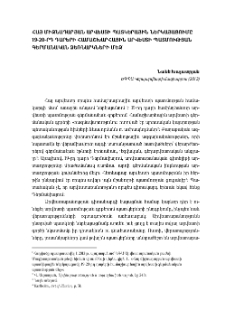Object
Title: Հայ միջնադարյան արվեստի պատկերային ներկայացումը 19-20-րդ դարերի համաշխարհային արվեստի պատմության գերմանական ձեռնարկների մեջ
Publication Details:
Journal or Publication Title:
Գեղարվեստի ակադեմիայի Տարեգիրք=Yearbook of the Academy of Fine Arts=Ежегодник академии художеств
Date of publication:
Number:
ISSN:
Official URL:
www.yearbook.yafa.am
Additional Information:
Khachatryan Nane, Хачатрян Нанэ
Other title:
Representation Of Medieval Armenian Art Through Images In 19th Century German World Art History Books ; Репрезентация средневекового армянского искусства с помощью изображений в немецких учебниках по истории мирового искусства в XIX веке
Corporate Creators:
Երևանի գեղարվեստի պետական ակադեմիա
Coverage:
Abstract:
This current study discusses the role and influence of the image in the discipline of art history, as well as the relations of the image with the text. Taking a preview about the development of the image – from old gravures to the recent photography techniques, we emphasize the changes taken place in the representation and structure of art history. In 19th century world art history books each epoch and country was classified by its way of representation. It was part of a wider policy led by Western European countries – mainly by Germany. Images, that are included in art history books, give them a special meaning: information that has its imagery “proof” is perceived to be much more reliable and impressive, thus, art history gains an important and independent role as a discipline that tells its statements through images. Switching from gravures to photography evokes issues like differences between illustration and reproduction or problems of distortion and authenticity of the images. These points are clarified and talked over in the examples of images representing Armenian art, that are included in the 19th century German world art history books. These were the first books about world art, which makes them an important and central case in this study.
В данном исследовании обсуждаются роль и влияние изображения в дисциплине истории искусств, а также отношения изображения с текстом. Просматривая развитие изображения - от старых гравюр до новейших технологий фотографии , мы подчеркиваем те изменения, которые произошли в методе репрезентации и структуре истории искусств. В учебниках мировой истории искусств в 19-ом веке каждая эпоха и страна были классифицированы по способу ее репрезентации. Эта было частью более широкой политики, которую вели страны Западной Европыи, в основном - Германия. Изображения , которые были включены в книги по истории искусств, давали книгам особый смысл: информация, которая имеет свое образное "доказательство", воспринимается как более надежная и впечатляющая, и таким образом, история искусств, как дисциплина, получает важную и самостоятельную роль, которая излагает свои утверждения изображениями. Переход с гравюр к фотографии вызывает такие вопросы, как различия между иллюстрацией и репродукцией, или проблемы искажения и подлинности изображений. Эти вопросы мы уточняем и обсуждаем на примере изображений, представляющих армянское искусство, которые включены в 19 веке немецкие книги по истории мирового искусства 19 века. Это были первые книги о мировом искусстве, чем и обусловливается их важное и центральное место в данном исследовании.
Place of publishing:
Երևան
Format:
Identifier:
oai:arar.sci.am:368270 ; doi:10.54503/1829-4278
Language:
Object collections:
Last modified:
Feb 4, 2024
In our library since:
Jan 17, 2024
Number of object content hits:
80
All available object's versions:
https://arar.sci.am/publication/398022
Show description in RDF format:
Show description in OAI-PMH format:
-
Գեղարվեստի ակադեմիայի Տարեգիրք=Yearbook of the Academy of Fine Arts=Ежегодник академии художеств
-
Գեղարվեստի ակադեմիայի Տարեգիրք, 2013, 1
- Կազմ; Խմբագրական խորհուրդ
- Բովանդակություն
- Սենմուրվը եւ սասանյան առասպելական կենդանիները հայ միջնադարյան արվեստում
- On the Common Program for the Architecture of Transcaucasia and its Neighbors (C. 300-1600)
- Հունաստանի պատկերը ԺԷ-ԺԸ դարերի հայկական պատկերացումներում
- Средневековая Европа в анфас и профиль или становление образа дьявола в христианстве
- Աստվածածնի պատկերները ժամանակակից հայ նկարիչների արվեստում
- Թումանյանի հերոսուհիները բնական իրավունքի եւ ավանդակեցության բախման ողբերգական հանգույցներում
- Взрыв в Дельфте в 1654 г.: первая документально изображенная техногенная катастрофа
- О драматургии балета «Спартак» Арама Хачатуряна
- Դրացիությունը հայոց ավանդական եւ արդի կենցաղում
- Քանդակագործ Գագիկ Ղազարյանի արվեստի վաղ շրջանի առանձնահատկությունները
- Պատկեր, գիր, անուն. Հին Եգիպտոսի դիմապատկերների շուրջ
- Պիտեր Բրեյգելը Պահքի եւ Կառնավալի միջեւ
- Հայ միջնադարյան արվեստի պատկերային ներկայացումը 19-20-րդ դարերի համաշխարհային արվեստի պատմության գերմանական ձեռնարկների մեջ
- Արվեստագետի եւ արվեստի քննադատի փոխհարաբերության մասին. երկու զուգահեռ հայ արվեստի պատմությունից
- Հայկական հնագույն բարձրաշխարհիկ կահույքը
- Analytical and Structural Study of the Tea House Painting Style
- Երեւանի Դալմա գարդեն մոլը համաշխարհային առեւտրային համալիրների դիզայնի համատեքստում
- Խաչելության պատկերագրության ձեւավորումը եւ առավել տարածված պատկերման եղանակները
- Эпическoe в современной скульптуре Армении
- Դիտարկումներ 1960-70-ականների հայ աբստրակտ արվեստի որոշ առանձնահատկությունների շուրջ
-
Գեղարվեստի ակադեմիայի Տարեգիրք, 2014-2015, 2-3
-
Գեղարվեստի ակադեմիայի Տարեգիրք, 2016, 4
-
Գեղարվեստի ակադեմիայի Տարեգիրք, 2017, 5
-
Գեղարվեստի ակադեմիայի Տարեգիրք, 2018, 6
-
Գեղարվեստի ակադեմիայի Տարեգիրք, 2019, 7
-
Գեղարվեստի ակադեմիայի Տարեգիրք, 2020, 8/1
-
Գեղարվեստի ակադեմիայի Տարեգիրք, 2020, 9/2
-
Գեղարվեստի ակադեմիայի Տարեգիրք, 2021, 10/1
-
Գեղարվեստի ակադեմիայի Տարեգիրք, 2021, 11/2
-
Գեղարվեստի ակադեմիայի Տարեգիրք, 2022, 12/1
-
Գեղարվեստի ակադեմիայի Տարեգիրք, 2022, 13/2
-
Գեղարվեստի ակադեմիայի Տարեգիրք, 2023, 14/1
-
Գեղարվեստի ակադեմիայի Տարեգիրք, 2023, 15/2
-
Գեղարվեստի ակադեմիայի Տարեգիրք, 2024, 16/1
-
Գեղարվեստի ակադեմիայի Տարեգիրք, 2024, 17/2
-
Գեղարվեստի ակադեմիայի Տարեգիրք, 2025, 18/1
-
Գեղարվեստի ակադեմիայի Տարեգիրք, 2013, 1





